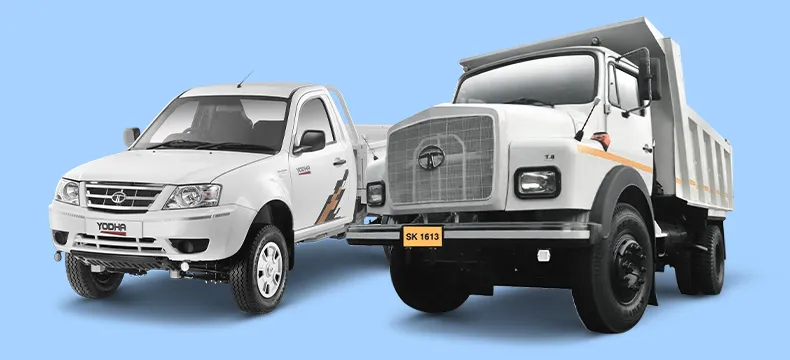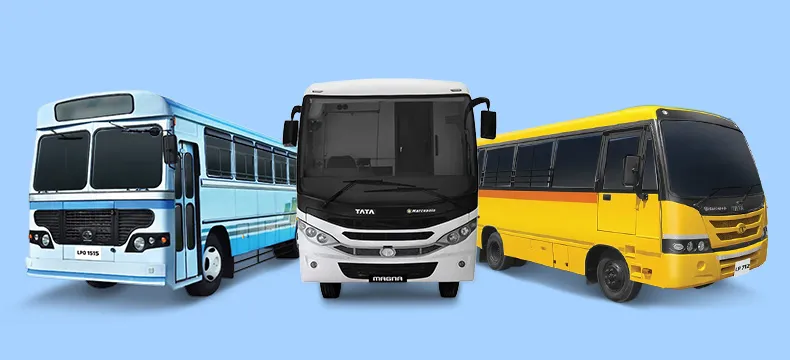17 Sep 2025

Road Transport vs Rail Transport in Nepal
- Tata Motors
- 30 Sep 2024
- COMMERCIAL VEHICLE
Introduction
In Nepal, the country's diverse geography and challenging terrain play a crucial role in determining the best modes of transportation. Road and rail transport are the two primary methods for transporting goods and passengers. Both modes have advantages and limitations, which are influenced by terrain, infrastructure, and economic conditions. In this article, we'll examine the key differences, benefits, and challenges of road transport vs rail transport in Nepal and explore how each contributes to the nation's logistics and development.
What is Road Transport?
Road transport is the most common method of transportation in Nepal and is a crucial lifeline for the country's economy. This mode of transport involves the use of trucks, buses, motorcycles, and other motor vehicles to move goods and people from one place to another. In Nepal, where mountainous terrain makes infrastructure development challenging, road transport is critical, especially in areas where railways do not exist.
The main advantage of road transport is its flexibility. Vehicles can travel to remote regions, deliver goods directly to their destination, and navigate rough terrains. Roads also serve as the main connectors between rural areas and urban centres, ensuring that local economies remain connected to larger markets.
What is Rail Transport?
Rail transport refers to moving goods and passengers using trains on tracks. While rail transport is not as prevalent in Nepal as in other countries, it has gained importance due to its ability to efficiently carry large volumes of goods over long distances. Nepal's railway network is limited but growing, with projects aimed at connecting more regions to neighbouring India and eventually creating a more comprehensive domestic rail system.
Compared to road transport, rail transport is more energy-efficient and cost-effective, especially for heavy and bulk goods. It also contributes less to environmental pollution, making it an increasingly popular choice for long-distance freight.
Advantages and Disadvantages of Rail and Road Transport
When comparing road transport and rail transport, it's important to weigh the advantages and disadvantages of each based on Nepal's unique terrain and logistical needs.
Advantages of Road Transport:
-
Flexibility:
One of the most significant advantages of road transport is its flexibility. Vehicles can travel to areas where there is no railway infrastructure, such as rural and mountainous regions.
-
Door-to-door Delivery:
Trucks and other vehicles offer door-to-door services, making road transport ideal for the last-mile delivery of goods.
-
Cost for Short Distances:
For short-haul transport, road transport is often more economical than rail, especially when the quantity of goods is small.
-
Infrastructure Reach:
Roads are more widely available than railway lines, providing easier access to remote areas.
Disadvantages of Road Transport:
-
Traffic Congestion:
As roads become more congested, the efficiency of road transport can decrease, leading to longer delivery times.
-
Weather-Dependent:
Road transport is more susceptible to disruptions from weather conditions such as landslides, flooding, or heavy rain, which are common in Nepal.
-
High Operational Costs:
Fuel costs, tolls, and vehicle maintenance contribute to higher operating expenses for road transport.
-
Environmental Impact:
Road transport contributes significantly to air pollution and greenhouse gas emissions.
Advantages of Rail Transport:
-
Energy Efficiency:
Rail transport is more energy-efficient than road transport, especially when large volumes of goods are transported over long distances.
-
Cost-Effective for Bulk Goods:
Rail transport is particularly cost-effective when transporting heavy or bulk items like construction materials, agricultural produce, or minerals.
-
Less Environmental Impact:
Compared to road vehicles, trains emit less CO2 per tonne-kilometre, making them a greener option.
-
Reduced Traffic Congestion:
Using rail transport reduces traffic congestion on the roads, easing traffic and reducing the likelihood of accidents.
Disadvantages of Rail Transport:
-
Limited Access:
Nepal's railway infrastructure is underdeveloped, limiting the reach of rail transport to only certain areas.
-
Initial Investment:
Setting up railways requires significant upfront investment in infrastructure, which can be a barrier to expansion.
-
Less Flexibility:
Unlike road transport, rail transport does not offer door-to-door services, requiring additional modes of transportation to complete the journey.
Key Differences of Rail and Road Transport
When we compare rail and road transport, the key differences in Nepal are primarily related to accessibility, capacity, and cost. Here are some of the notable distinctions:
-
Infrastructure Availability:
Road transport is more widely available in Nepal, with an extensive network of roads that connect urban centres and rural areas. In contrast, rail transport is limited to specific regions, with a growing but still minimal infrastructure.
-
Cost Efficiency:
For short distances and smaller loads, road transport is typically more cost-effective. However, rail transport has become more economical for long-distance and bulk transportation due to its lower operational costs per tonne-kilometre.
-
Speed and Reliability:
While rail transport tends to be more reliable and faster for long distances, road transport can navigate a variety of terrains and deliver goods directly to their destination.
-
Environmental Impact:
Trains produce fewer emissions compared to trucks and other vehicles, making rail transport a more environmentally friendly option for bulk freight.
Rail and Road Transport – Contribution to GDP
Both road transport and rail transport play important roles in contributing to Nepal's GDP. However, road transport currently dominates the transportation sector, facilitating more than 90% of the country's total cargo and passenger movement. This reliance on road transport is primarily due to the limited development of railways and the flexibility that road vehicles offer in reaching remote and mountainous areas.
As Nepal continues to invest in its railway infrastructure, rail transport is expected to increase its contribution to the GDP, particularly in sectors such as mining, agriculture, and cross-border trade with India. However, it will take time and significant investment for rail transport to challenge the dominance of road transport in the country.
Freight Traffic of Road vs Rail
When comparing road transport vs rail transport for freight traffic in Nepal, the majority of goods are moved by road. Trucks, such as the Tata Yodha DC and Tata SK 1613, are the preferred choice for transporting goods over short and medium distances, especially in regions with limited railway access. The flexibility of road freight makes it an essential part of the country's supply chain.
In contrast, rail transport handles a smaller volume of freight, mainly focusing on bulk goods transported over long distances. This includes construction materials, minerals, and cross-border trade with India. While rail transport is more efficient for such tasks, its limited infrastructure means that it cannot yet compete with the volume handled by road freight in Nepal.
Conclusion
In Nepal, both road transport and rail transport have unique strengths and challenges. Road transport offers flexible door-to-door services and is more prevalent due to the extensive road network. On the other hand, rail transport is more cost-effective for bulk goods and long-distance freight but is limited by the country's developing railway infrastructure.
As the country continues to invest in its transportation infrastructure, finding the right balance between road and rail transport will be key to improving logistics efficiency and supporting economic growth.
FAQs
What is the difference between road transport and rail transport?
The main difference between road transport and rail transport lies in flexibility and capacity. Road transport is more flexible and can provide door-to-door service, while rail transport is more efficient for moving bulk goods over long distances but is limited by infrastructure.
What is the disadvantage of rail transport?
One of the main disadvantages of rail transport in Nepal is the limited railway infrastructure, which restricts the regions where trains can operate. Additionally, rail transport lacks the flexibility to provide door-to-door services.
What are the advantages of road transport?
Road transport is flexible, widely available, and provides door-to-door delivery services. It is ideal for short-distance travel and navigating difficult terrains like the mountainous regions of Nepal, making it a crucial mode of transport for both goods and passengers.
- Tags
Latest Blogs


10 Sep 2025
What Exactly Is Torque in A Truck Engine?

10 Sep 2025


















